|
ACT III, PART II
Photographs reveal that when the south tower first began to
collapse, it was definitely not in a symmetrical manner. To the
contrary, WTC2 first began to collapse in exactly the way that one
would expect a tower to collapse after an airplane had ripped away
one corner: the intact upper portion of the building, above the
point of impact, began to tilt precariously toward the point of
structural weakness. It is perfectly obvious that this was not the
onset of a symmetrical, ’pancake’ collapse.
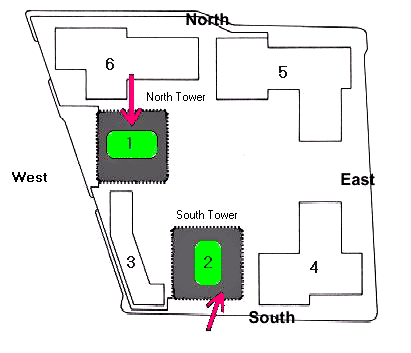 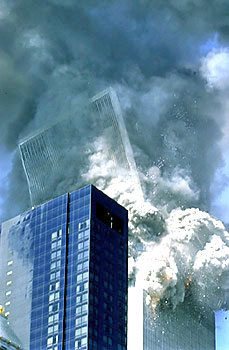
How then did it become, literally in the blink of an eye, a
perfectly symmetrical collapse? With no other forces acting upon it,
gravity and momentum should have sent the enormous block of concrete
and steel crashing down alongside the topless tower, likely on top
of WTC4. But that isn’t what happened. Instead, something very
peculiar happened -- something that can be seen in the series of
photos to the lower right.
|
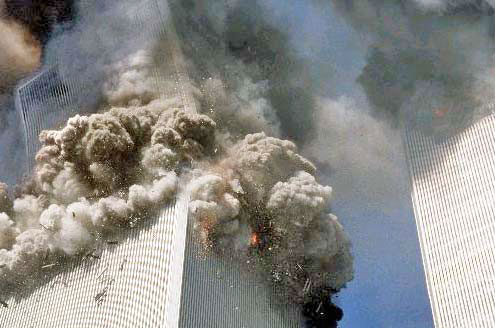 |
Instead of continuing to topple over, the massive block seems to
have mysteriously self-destructed. But how could that have happened?
The upper portion of the tower certainly couldn’t have ’pancaked,’
unless it did so from the bottom up. And smoke and fire don’t
normally cause large chunks of steel-framed buildings to suddenly blow apart. That usually only happens when
explosives of some kind are involved. And if the top of the
tower blew apart, than what was it that provided the impetus for the
’pancaking’ of the remainder of
the tower?
The photo to the top left reveals that the collapse of the north tower
began asymmetrically as well. As was the case with the south tower,
the upper portion of the north tower, above the point of impact,
began to tilt as a solid block toward the point of the initial
structural damage. But in a virtual instant replay, the asymmetrical
collapse of WTC1 was instantaneously transformed into a perfectly
symmetrical collapse.
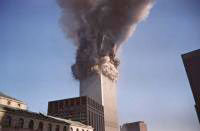 What could have caused the tops of the towers to suddenly begin
toppling over? That would seem to require that the massive steel
cores of the towers simply snapped at the point of impact, allowing
the upper portions of the towers to completely break free from the
lower portions -- even though, in the case of the south tower at
least, there was likely minimal structural damage to the building’s
core from the initial impact and explosion. What could have caused the tops of the towers to suddenly begin
toppling over? That would seem to require that the massive steel
cores of the towers simply snapped at the point of impact, allowing
the upper portions of the towers to completely break free from the
lower portions -- even though, in the case of the south tower at
least, there was likely minimal structural damage to the building’s
core from the initial impact and explosion.
The only way to get the World Trade Center towers to drop straight
down was to eliminate the central support structure. The best way to
do that would have been to blast away a portion of each of those 47
core columns, down near where they were anchored to the bedrock,
causing the entire central core of the tower to abruptly drop a
given distance, which would begin to pull each of the floors down
toward the center of the building’s footprint. As this happened, the
entire load of the tower would have been transferred, instantaneously, onto the exterior shell, which was not engineered
to support such a load.
What we are looking at in the photos showing the tilting tower tops
are images captured in that very brief moment in time after the core
had dropped and the load had been transferred to the building’s
exterior skeleton. In other words, although the towers still appear
to be intact, they have already begun to collapse from within. With
the core support gone, the unsupported upper shell immediately began
to tilt toward the point of impact. But even as that occurred, the
entire tower was beginning a top-to-bottom collapse precipitated by
the drop of the core.
Early news reports, broadcast before the official spin had set in,
acknowledged that the collapses had been assisted by explosives.
NBC
correspondent Pat Dawson, for example, stated the following on the
air:
"The Chief of Safety of the Fire Department of New York told me
that, uhh, he thinks that there were actually devices that were
planted in the building. One of the secondary devices he thinks that
took place after the initial impact was, he thinks, may have been on
the plane that crashed into one of the towers. The second device, he
thinks, he speculates, was probably planted in the building, uhh, so
that’s what we have been told by, uhh, Albert Turi, who is the Chief
of Safety for the New York City Fire Department, he told me that
just moments ago."
A radio broadcaster on station WLS in
Chicago, whose former
colleague was on the scene at the towers, reported that this
colleague had witnessed an enormous fireball emanating from beneath
one of the towers immediately before it came crashing down. Such a
fireball would, of course, be entirely consistent with the collapse
scenario just outlined. Also consistent with that scenario are the
multiple reports of pools of molten steel found in the basements of
the towers days after the collapses.
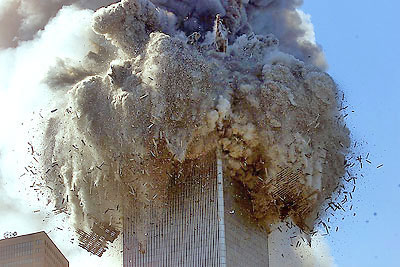
Steve Evans, a correspondent for the
BBC, reported the following on
the air:
"I was at the base of the 2nd tower, the second tower that
was hit. There was an explosion -- I didn’t think it was an
explosion, but the base of the building shook. I felt it shake, then
when we were outside, the second explosion happened and then there
was a series of explosions. We can only wonder at the kind of damage
-- the kind of human damage -- which was caused by those explosions,
those series of explosions."
On September 24, 2001, People Weekly published an interesting
witness account provided by Louie Cacchioli, one of the first
firefighters to enter the south tower:
"I was taking firefighters up
in the elevator to the 24th floor to get in position to evacuate
workers. On the last trip up a bomb went off. We think there were
bombs set in the building."
Teresa Veliz, who was on the 47th floor of the north tower when it
was hit, told her survivor story in Dean Murphy’s September 11: An
Oral History (Doubleday, 2002):
"The flashlight led us into Borders
bookstore, up an escalator and out to Church Street. There were
explosions going off everywhere. I was convinced that there were
bombs planted all over the place and someone was sitting at a
control panel pushing detonator buttons. I was afraid to go down
Church Street toward Broadway, but I had to do it. I ended up on Vesey Street. There was another
explosion. And another. I didn’t
know where to run."
In mid-December 2001, USA Today revisited the collapse of the towers
in a compelling series of articles written by Dennis Cauchon. The
first of the articles, published December 18, included an account of
survivor Ronald DiFrancesco’s encounter with a fireball at the base
of the south tower:
"As he left the building, he saw a
fireball
rolling toward him. He put his arms in front of his face. He woke up
three days later at St. Vincent’s hospital. His arms were burned.
Some bones were broken. His lungs were singed. But he was alive--the
last person out of the south tower."
(Dennis Cauchon "Four Survived by Ignoring Words of Advice," USA
Today, December 18, 2001
http://www.usatoday.com/news/sept11/2001/12/19/usat-escape.htm)
The second article focused on an interesting, if not necessarily
directly relevant, aspect of the tower attacks:
"When the World
Trade Center was bombed in 1993, Otis Elevator’s mechanics led the
rescue of 500 people trapped in elevators. Some mechanics were
dropped onto the roofs of the twin towers by helicopter. Others,
carrying 50-pound oxygen tanks on their backs, climbed through smoke
to machine rooms high in the towers. On Sept. 11, the elevator
mechanics - many of the same men involved in the rescues in 1993 -
left the buildings after the second jet struck, nearly an hour
before the first building collapsed ... The departure of elevator
mechanics from a disaster site is unusual."
(Dennis Cauchon "Mechanics Left Towers Before Buildings Collapsed,"
USA Today, December 19, 2001
http://www.usatoday.com/news/sept11/2001/12/19/usat-mechanics.htm)
The third article, published December 20, was an analysis of who
survived the collapses, and who did not. It was by far the most
compelling article in the series. Among the revelations was that the
twin towers were very sparsely occupied that day:
"USA Today
estimates 5,000 to 7,000 people were in each tower when the attack
began. Earlier estimates ranged from 10,000 to 25,000 per tower. But
company head counts show many desks were empty at 8:46 a.m."
(Dennis Cauchon "For Many On Sept.11, Survival Was No Accident ,"
USA Today, December 20, 2001
http://www.usatoday.com/news/sept11/2001/12/19/usatcov-wtcsurvival.htm)
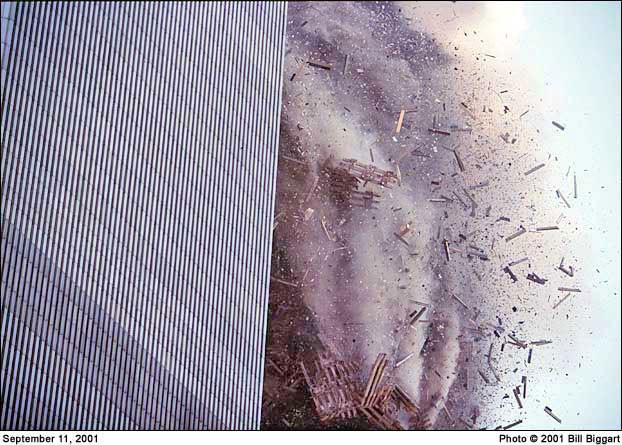
Cauchon offered some specific examples of the pattern of occupancy
that day:
"For example, Marsh & McLennan, an insurance company, had
offices on the 93rd through 100th floors in the north tower. About
1,000 worked there; 295 were at work at the time. All died. Fred
Alger Management, a money manager, occupied most of the 93rd floor.
Thirty-five of 55 employees were in. They all died. Only 25 of 55
employees were in the New York Metro Transportation Council’s 82nd
floor office. Three died. The receptionist was the only person in
the office at the 16-employee law firm of Drinker Biddle & Reath on
the 89th floor. She lived."
Perhaps this would be a good time to pause and reflect on a rather
uncanny series of ’coincidences’: as we recall from Act I, all four
of the hijacked aircraft took off with far more empty seats than
filled ones; as was mentioned in Act II, the Pentagon was impacted
in a section that had just been renovated and was not yet fully
reoccupied; and now we find, curiously enough, that the other two
targets, the twin WTC towers, were sparsely occupied as well. Maybe
Allah just wasn’t on the terr’ists side that day.
USA Today determined that,
"In each tower, 99% of the occupants
below the crash survived. At the impact area and above, survival was
limited to just a handful of people in the south tower who made an
amazing escape."
If the towers had not collapsed, the majority of
the people trapped above the impact area would most likely have been
rescued (especially if the elevator mechanics had stuck around to
assist the other rescue personnel). In addition, virtually all of
the 479 rescue workers killed that day would have survived as well.
In other words, the already surprisingly low death toll from the
tower attacks would have been considerably lower. So again the
question needs to be raised: would ’9-11’ have had nearly the impact
on the American psyche if the towers had not fallen?
One of the lingering questions surrounding the collapse of the
towers is why the south tower fell just 56 minutes after impact,
while the north tower held for 102 minutes -- nearly twice as long.
Just days after the attacks, I speculated in one of my meandering
rants that perhaps the south tower was brought down first because it
was evacuated first, owing to the fact that the occupants of the
south tower received advance warning via the crash into the north
tower, and therefore had the benefit of beginning evacuation before
the south tower was hit and all hell broke loose. At the time that
post went up, most respondents seemed to find that idea absurd, and
news reports repeatedly claimed that occupants of the south tower
did not in fact begin evacuating after the strike on the north
tower, but rather were advised to remain in their offices.
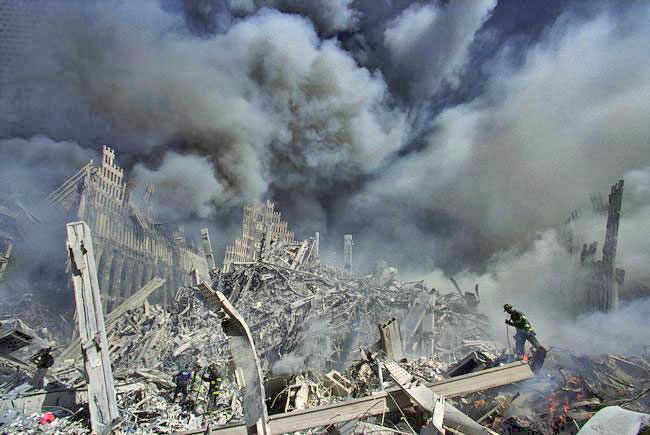
USA Today concluded otherwise after talking to numerous survivors:
"Most of the dead were in the north tower, the
first one hit and the
second to collapse. USA Today documented 1,434 who died in the north
tower vs. 599 in the south tower. (Locations could not be determined
for 147 of the building occupants.) An analysis shows that
two-thirds of south tower occupants evacuated the upper floors
during the 16 1/2 minutes between the attacks. In the north tower,
an average of 78 people died per floor at the crash area and above,
compared with 19 people per floor in the south tower."
The occupants of the south tower had both advance warning and the
benefit of utilizing the building’s ninety-nine elevators, which is
obviously a much quicker way to exit than walking, single file, down
as many as 110 flights of stairs. So even though the south tower was
hit at a lower elevation, thus potentially trapping far more people,
and even though it stood for only half as long, more than twice as
many people died in the north tower. It seems entirely reasonable
then to speculate that the south tower was brought down first
because it was ’cleared’ first (for lack of a better word).
The USA Today report seemed to subtly suggest that scenario:
"The
evacuation was a success. Nearly everyone who could get out did get
out. The Port Authority had revised its evacuation plan for the
buildings after a terrorist bomb exploded in a Trade Center garage
in 1993. On Sept. 11, those changes saved hundreds, possibly
thousands, of lives. The buildings, sturdily constructed,
exquisitely engineered and equipped with stairwells bigger than
building codes require, stood just long enough to give potential
survivors a chance to get out." (emphasis added)
The reason the evacuation was a success, according to
USA Today, was
because of the lessons learned from the February 26, 1993 bombing of
the World Trade Center. At the time of that attack,
"The evacuation
took nearly four hours in dark, smoky, poorly marked stairwells.
Some people were stuck in elevators for 10 hours. The Port Authority
made crucial improvements after that attack. The changes saved
countless lives on Sept. 11."
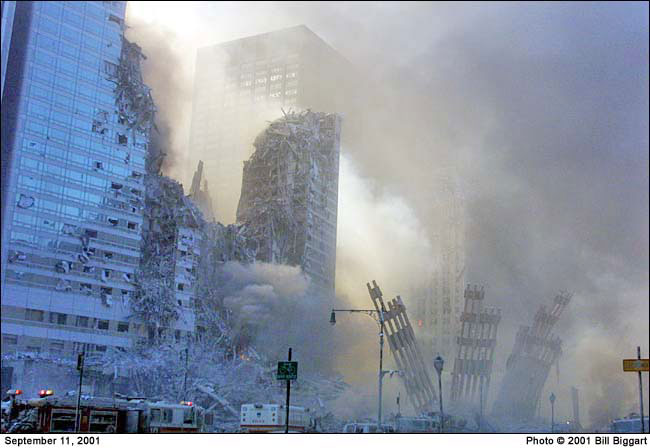
Those improvements included the addition of a back-up power supply,
fire command posts, stairwell lighting with battery back-up,
loudspeakers, reflective paint and directional arrows. In addition,
evacuation drills were reportedly held every six months. Taking all
that into consideration, and also taking into consideration that the
1993 WTC bombing was carried out by operatives under the supervision
of the FBI, a skeptic might be tempted to conclude that the 1993
’attack’ was really a test to see how quickly the buildings could be
evacuated in an actual emergency.
One final intriguing nugget of information included in the USA Today
report is that just "Ten bystanders were killed by falling debris."
If true, that is a remarkable statistic. So precisely controlled
were the collapses that two 1,360-foot-tall towers fell in the
densely populated heart of Manhattan and just ten bystanders were
killed! And yet we are expected to believe that those uncannily
symmetrical collapses were caused by airplanes striking the
buildings at entirely random points.
Following the pattern set at the Pentagon, virtually all of the
key
evidence concerning the attacks on the towers has been suppressed.
The contents of the infamous ’black boxes’ remain a mystery. Only
bits and pieces of the seventy-eight-minute audiotape of
firefighters working within the stricken towers have been released.
And perhaps most troubling of all, the structural steel from the
towers was quickly shipped overseas as scrap, preempting an
investigation that could have determined whether the collapses were
caused by fire or explosives:
Some 185,101 tons of structural steel have been hauled away from
Ground Zero. Most of the steel has been recycled as per the city’s
decision to swiftly send the wreckage to salvage yards in New
Jersey. The city’s hasty move has outraged many victims’ families
who believe the steel should have been examined more thoroughly.
Last month, fire experts told Congress that about 80% of the steel
was scrapped without being examined...
(New York Daily News, April 16, 2002)
For more than three months, structural steel from the World Trade
Center has been and continues to be cut up and sold for scrap.
Crucial evidence that could answer many questions about high-rise
building design practices and performance under fire conditions is
on the slow boat to China, perhaps never to be seen again in America
until you buy your next car... Fire Engineering has good reason to
believe that the "official investigation" blessed by FEMA and run by
the American Society of Civil Engineers is a half-baked farce that
may already have been commandeered by political forces whose primary
interests, to put it mildly, lie far afield of full disclosure.
Except for the marginal benefit obtained from a three-day, visual
walk-through of evidence sites conducted by ASCE investigation
committee members - described by one close source as a "tourist
trip"- no one’s checking the evidence for anything.
(Fire Engineering Magazine, January 2002)
Federal officials overseeing the clean-up operation, in conjunction
with Giuliani’s office, resorted to extraordinary measures to insure
that none of the steel went missing on the way to the official
dumpsite, purportedly to thwart an alleged criminal operation aimed
at stealing the scrap steel.
On November 26, the city initiated use of an in-vehicle GPS tracking
system to monitor locations of trucks hired to haul the debris to
Fresh Kills, the official dump site on Staten Island ... In the
weeks before launching the GPS system, the city relied on a
paper-based system for tracking traffic and loading data. Police and
several other agencies teamed up to monitor the trucks on their
routes between Ground Zero through 20 to 30 miles of tunnels,
bridges and highways to the dump on Staten Island ...
To get a GPS
truck-monitoring system rolling right away, DDC-NYC and the New York
Port Authority (NYPA) quickly identified several possible suppliers,
viewed presentations from the candidates, and sent out a request for
proposal. In the end, the contract went to IDC-Criticom, a large
alarm system wholesaler based in Minneapolis, and its two
subcontractors: GPS hardware maker PowerLoc; and implementation
specialist Mobile Installation Technologies (MIT) of Marietta, Ga.
Within three weeks, the system elements were in place, and nearly
200 trucks in New York City were being tracked in real time.
Installed by MIT with assistance from PowerLoc and four trucking
contractors, the solution revolved around PowerLoc’s Vehicle
Location Device (VLD). Each VLD unit costs about $1,000.
(http://securitysolutions.com/ar/security_gps_job_massive/)
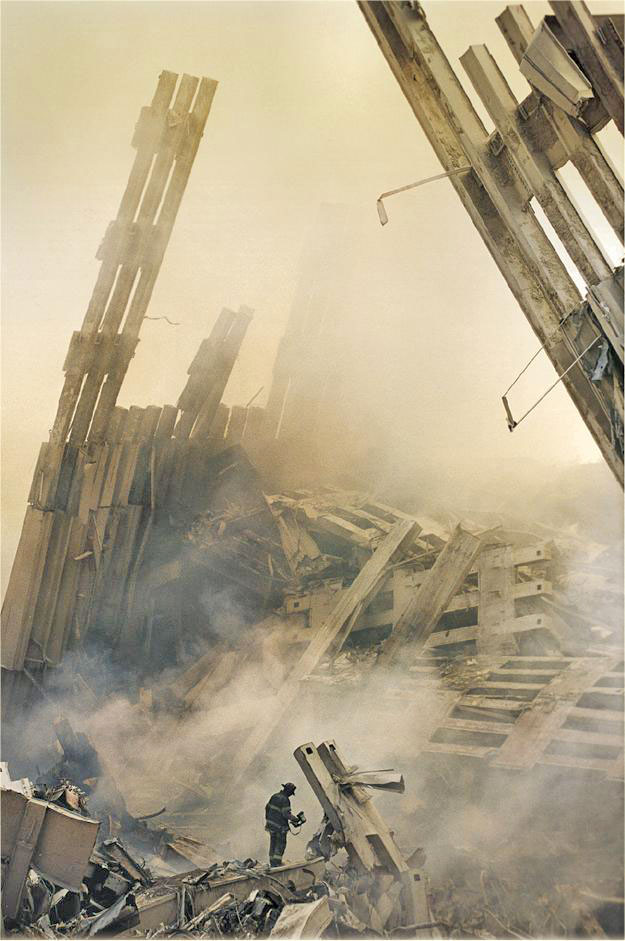
Since ’Ground Zero’ was, by all accounts,
the site of a mass murder,
the actions taken collectively by federal officials amounted to
nothing less than the willful, deliberate destruction of evidence in
a criminal investigation. If the collapse of the towers was due to
an unprecedented, spontaneous failure of structural components of
the buildings, then a full and rigorous investigation was mandated
to insure that new construction methods could be implemented in
future high-rise projects, and so that existing buildings at risk
could be identified. If, on the other hand, the collapse of the
towers was due to strategically placed, synchronized explosive
charges, then only the appearance of an investigation was necessary,
for two rather obvious reasons:
(1) those who need to know already
know why the towers collapsed
(2) they don’t want anyone else
to know why the towers collapsed
As it did with all aspects of the September 11 attacks, the
Bush
administration chose to go with the appearance of an investigation.
In addition to the suppression of the firefighter tape and the
willful destruction of the forensic evidence, an invaluable source
of information on the collapses was destroyed when WTC7 collapsed.
Housed on the twenty-third floor of the building was Mayor
Giuliani’s Office of Emergency Management, a state-of-the-art
command center designed to serve as a base of operations during
times of crisis. On September 11, 2001, the command center was
monitoring the situation in lower Manhattan -- at least it was until
the personnel staffing the center received an order to evacuate. One
of the officials manning the command center that day told filmmakers
from The History Channel that,
"to this day, we don’t know who gave
that order."
("The World Trade Center: Rise and Fall of an American Icon," The
History Channel, September 8, 2003)
Excuse me? How could they not know who gave that order? How many
people, other then the mayor, were authorized to issue such an
order? The city’s emergency command center, the very entity set up
to advise others how to proceed in times of crisis, was itself
ordered to shut down in the middle of the worst crisis the city had
ever faced, and no one knows who gave that order?! Am I the only one
who finds that a little hard to believe?
The History Channel also spoke with a Colonel John O’Dowd, of the
U.S. Army Corps of Engineers. O’Dowd, who is no stranger to disaster
scenes, said that he had never seen anything like what he saw at the
site where the towers had once stood. "At the World Trade Center
sites," he said, "it seemed like everything was pulverized." Other
than the miles of twisted steel beams and columns, there was nothing
recognizable in the debris pile -- nothing to indicate that the
pulverized debris had been, just seconds earlier, a functioning
10,000,000-square-foot office building.
Colonel O’Dowd had also been present at the scene of the partially
collapsed Oklahoma City Federal Building. Though the collapse of the Murrah building was definitely facilitated by at least one powerful
explosive charge, O’Dowd noted that the debris from that collapse
was not pulverized to the degree that it was at the site of the WTC
towers. And the towers, according to the official story, were acted
upon by nothing more than the effects of fire and gravity.
Curiously enough, the contractor hired to finish off the Murrah
building, and then haul all the debris off to an unmarked desert
grave, was the same contractor brought in to oversee the
clean-up/cover-up of the WTC tower debris. That contractor is
Controlled Demolitions, Inc., which happens to be the biggest name
in the controlled demolition industry, begging the question of
whether CDI’s WTC contract included payment for more than just
cleaning up the aftermath of the collapses.
If the World Trade Center towers were brought down with explosives,
which is the only reasonable explanation for what the world
witnessed, then a considerable amount of advance work would have had
to be done. Such an operation presumably would have had to be run
through the WTC’s security service, since that is the entity given
unrestricted access to the buildings, and, of equal importance, the
entity with the authority to restrict the access of others.
A business entity now known as Stratesec, Inc. began performing
security work at the World Trade Center in 1993. In 1996, the
company, then known as Securacom, was awarded an exclusive contract
to provide security for the World Trade Center complex.
Stratesec/Securacom also provided security for United Airlines and
Dulles International Airport, two other key players in the 9-11
story. Sitting on Stratesec’s board of directors, from the time the
company began working at the WTC, was a major shareholder by the
name of Marvin Bush. Marvin, like Jeb and Neil, is a
brother of
George W. Bush. Small world, isn’t it?
As with other aspects of the September 11 story, there is,
unfortunately, a considerable amount of disinformation mixed in with
the ’9-11 skeptics’ literature concerning the collapse of the
towers. One widely disseminated bit of said disinformation concerns
a statement by building leaseholder Larry Silverstein, who was
interviewed for a PBS documentary entitled "America Rebuilds."
During that interview, Silverstein recalled,
"getting a call from
the, uh, fire department commander, telling me that they were not
sure they were gonna be able to contain the fire, and I said, ’You
know, we’ve had such terrible loss of life, maybe the smartest thing
to do is, is pull it.’ And they made that decision to pull and then
we watched the building collapse."
Many researchers have suggested that Silverstein admitted on public
television that he and the FDNY made a joint decision to bring WTC7
down in a controlled demolition. This is a particularly nasty line
of disinformation because it casts the FDNY, universally viewed (and
rightfully so) as the heroes of 9-11, as co-conspirators in bringing
the buildings down.
It is perfectly clear from the context of Silverstein’s statement
that he was not suggesting that the building be brought down, but
rather that fire fighting operations be suspended. The "terrible
loss of life" he referred to was obviously the loss of scores of
firefighters in the twin tower collapses, and his point was that it
wasn’t worth putting any more firefighters at risk, particularly in
a building that had long since been evacuated.
In what parallel universe would a building owner casually suggest to
the fire department that his building be brought down in a
controlled demolition, as if such a thing can be engineered on the
spot? And how exactly would collapsing an intact building save
lives? At least one researcher claims that proof that the phrase
"pull it" refers to demolishing the building can be found in the
same PBS documentary in the statement of a rescue worker who
recalled "getting ready to pull building six."
Apparently, triggering the controlled demolition of high-rise
buildings is a fairly common tactic during rescue operations.
Everybody seems to be familiar with it and everyone speaks rather
openly about it. Who knew?
There is one little problem with the ’proof,’ unfortunately: WTC6
wasn’t actually brought down in a controlled demolition. Like WTC7,
it was completely evacuated. It was also damaged beyond repair by
debris from the north tower. But it did remain standing. It is quite
clear then that "pull," in this context, refers to pulling
firefighters out of the building, since there was no reason for
anyone to further risk their life in a building that couldn’t be
saved.
Far from candidly admitting that he had ordered the demolition of
WTC7, what Silverstein was actually doing was lying to explain why
no effort was made to control the easily controllable fires that
purportedly brought the building crashing down.
Another morsel of disinformation that can be found in the skeptics’
literature is exemplified by Michael Ruppert’s claim that
"WTC
Building 7, which was not struck by an aircraft at all ... collapsed
faster than gravity would permit."
WTC7, along with WTC1 and WTC2,
fell at nearly the speed that gravity would permit, indicating that
the building offered virtually no resistance to the collapse. It did
not, however, fall "faster than gravity would permit," which would
be a physical impossibility. The only function served by inserting
such absurdities into the narrative is to discredit the body of
research that has been developed.
(http://www.fromthewilderness.com/free/ww3/112603_kennedy.html)
As fate would have it, the Los Angeles Times announced, as I was
working on this post, that a new report on the collapse of the
towers will be released by the end of the year:
Federal investigators believe the second World Trade Center tower
fell much more quickly than the first because it had a more
concentrated, intense fire inside, officials said Tuesday. The
detailed hypothesis was discussed at a meeting of investigators with
the National Institute of Standards and Technology, part of the
Commerce Department. The Institute’s investigators are preparing a
report detailing how and why the towers collapsed after being struck
by fuel-filled jetliners on Sept. 11, 2001. The report is to be
released by year’s end.
("9/11 Tower’s Fall Tied to Intensity of Fire," Los Angeles Times,
October 20, 2004)
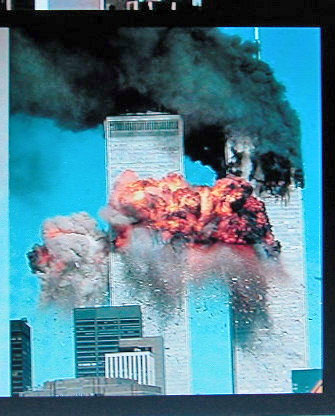 Apparently, Washington is preparing to add yet another layer to the
cover-up with yet another entirely fraudulent report. The notion
that the south tower played host to a "more concentrated, intense
fire" flies in the face of all the available evidence. As previously
discussed, the plane that hit the south tower clipped a corner of
the building, while the north tower was hit head-on. The result was
that the vast majority of the fuel from the second aircraft was
ejected out the side of the building, where it burned up immediately
in a massive fireball, as can be clearly seen in the photo to the
left. Apparently, Washington is preparing to add yet another layer to the
cover-up with yet another entirely fraudulent report. The notion
that the south tower played host to a "more concentrated, intense
fire" flies in the face of all the available evidence. As previously
discussed, the plane that hit the south tower clipped a corner of
the building, while the north tower was hit head-on. The result was
that the vast majority of the fuel from the second aircraft was
ejected out the side of the building, where it burned up immediately
in a massive fireball, as can be clearly seen in the photo to the
left.
Also clearly visible in the photo is that, in the north tower,
impacted just 16˝ minutes earlier, the flames had already died down
and copious amounts of thick, black smoke were pouring out of the
building, indicating a smoldering, oxygen-deprived fire, not a
raging inferno. The truth is that there were no "concentrated,
intense fires" burning in either of the towers, as photographs,
videotape, survivor accounts, and the firefighter audiotape all
amply document.
There were no intense fires for the simple reason that there was no
fuel available to feed such blazes. Though the general public
remains convinced that jet fuel fed the infernos, it has been
acknowledged that such was not the case. Experts consulted by the
Discovery Channel ("Collapse: How the Towers Fell," September 7,
2003) noted that jet fuel can burn quite fiercely, purportedly at
temperatures approaching 2,000° F, but not for very long. At least
one-half of the aircraft’s fuel burned outside of the towers, it was
acknowledged, and the remaining half, which ignited inside the
towers, would have burned up in about eight minutes.
Even the heavily whitewashed
FEMA report concurred with that
assessment:
"The large quantity of jet fuel carried by each aircraft
ignited upon impact into each building. A significant portion of
this fuel was consumed immediately in the ensuing fireballs. The
remaining fuel is believed either to have flowed down through the
buildings or to have burned off within a few minutes of the aircraft
impact. The heat produced by this burning jet fuel does not by
itself appear to have been sufficient to initiate the structural
collapses."
We are left then with the problem of identifying a fuel source that
could have allowed the fires to continue burning for a significant
amount of time at the extreme temperatures required to cause the
complete failure of structural steel. In a modern commercial office
building, such fuel sources are hard to come by. The cores of the
WTC towers, which contained elevator shafts, stairwells, and
mechanical shafts, were constructed largely of concrete, steel and
drywall. The exterior skeleton was a lattice work of structural
steel elements. The exterior facade was constructed of aluminum and
glass. The floor slabs were composed of steel trusses, corrugated
steel decking, and lightweight concrete. Interior walls were
constructed of light-gauge steel studs and fire-resistant drywall.
Ceilings typically consist of a steel grid system and fire-resistant
mineral fiber panels.
As a general rule, none of those building materials provide much
fuel for a fire. The only readily available fuel would have been
some of the decorative construction materials, such as carpet and
draperies, and whatever was provided by the building’s tenants,
primarily office furniture and paper products. None of that would
have come close to sustaining a fire of sufficient intensity to
cause the collapse of the towers, which were, by the way,
retrofitted with fire-sprinkler systems capable of handling routine
office fires.
Even if we accept the claim that fires raged in the towers with
enough intensity to cause the spontaneous failure of structural
steel elements, and even if we accept that those elements failed in
a uniform, perfectly symmetrical manner, and even if we simply
ignore the fact that the cores of the towers were inexplicably
pulverized, we still are left with no explanation of how WTC7 -
which did not have an open floor plan that could have rendered it
susceptible to ’pancaking,’ and which was not hit by a fuel-laden
airplane - imploded in essentially the same manner as the towers,
and on the very same day.
Let’s just suppose, for the moment, that a decision was made, at
some point in time, to rid New York City of the World Trade Center
towers. Under normal circumstances, that would have been nearly
impossible to accomplish. Even with the most carefully controlled
demolitions, it simply would not be possible to bring the gargantuan
towers down without doing a considerable amount of collateral damage
to surrounding buildings. And it’s a fairly safe bet that the toxic
clouds of dust that blanketed much of Manhattan would not have been
well received.
But if those collapses could be packaged into the Hollywood-style
production known as the September 11 terr’ist attacks, then two
birds could be killed with one stone: the towers could be brought
down, and it could be done in the most spectacular way possible,
thus traumatizing the nation and properly conditioning the people to
accept the prepackaged, post-911 agenda.
If that was indeed the plan, then it appears to have been a
successful one.
|







 What could have caused the tops of the towers to suddenly begin
toppling over? That would seem to require that the massive steel
cores of the towers simply snapped at the point of impact, allowing
the upper portions of the towers to completely break free from the
lower portions -- even though, in the case of the south tower at
least, there was likely minimal structural damage to the building’s
core from the initial impact and explosion.
What could have caused the tops of the towers to suddenly begin
toppling over? That would seem to require that the massive steel
cores of the towers simply snapped at the point of impact, allowing
the upper portions of the towers to completely break free from the
lower portions -- even though, in the case of the south tower at
least, there was likely minimal structural damage to the building’s
core from the initial impact and explosion.




 Apparently, Washington is preparing to add yet another layer to the
cover-up with yet another entirely fraudulent report. The notion
that the south tower played host to a "more concentrated, intense
fire" flies in the face of all the available evidence. As previously
discussed, the plane that hit the south tower clipped a corner of
the building, while the north tower was hit head-on. The result was
that the vast majority of the fuel from the second aircraft was
ejected out the side of the building, where it burned up immediately
in a massive fireball, as can be clearly seen in the photo to the
left.
Apparently, Washington is preparing to add yet another layer to the
cover-up with yet another entirely fraudulent report. The notion
that the south tower played host to a "more concentrated, intense
fire" flies in the face of all the available evidence. As previously
discussed, the plane that hit the south tower clipped a corner of
the building, while the north tower was hit head-on. The result was
that the vast majority of the fuel from the second aircraft was
ejected out the side of the building, where it burned up immediately
in a massive fireball, as can be clearly seen in the photo to the
left.